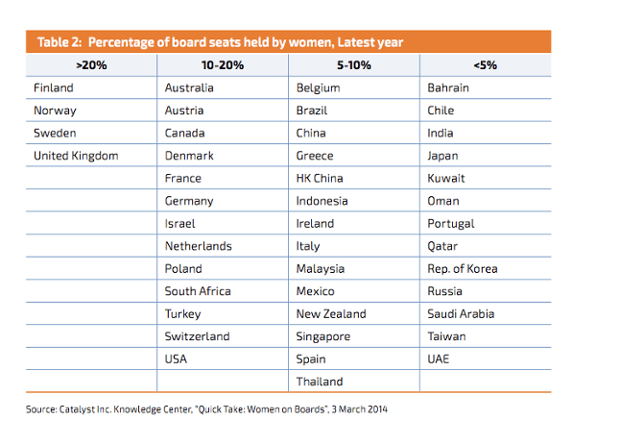More women than ever before are managers and business owners, but there is still a dearth of women at the top of the corporate ladder, says the International Labour Organization
The number of women in senior and middle management positions around the world has increased over the last 20 years but women are still under-represented in top management, according to a wide-ranging new study.
There has been progress on getting more women into management but it is slow and at this pace it will be more than 100 years before parity is achieved, according to the International Labour Organization. Its Bureau for Employers’ Activities has brought together data from around the world to try to provide the most up-to-date and global picture on women in the business world.
Women in Business and Management: Gaining Momentum ranks countries by female board representation and women in management and makes the case for more women at the top of business.
Here are six key findings from the report.
The glass ceiling is cracked but still intact
The ILO says the glass ceiling said to keep women out of top management roles has cracked but not shattered entirely.
More women than ever before are managers and business owners, but there is still a dearth of women at the top of the corporate ladder, says the ILO.
In 80 of the 108 countries for which ILO data is available, the proportion of women managers has increased over the last 20 years. But only 5% of the CEOs of the world’s largest corporations are women. The larger the company, the less likely the head will be a woman, the study found.
The Dominican Republic leads the world for women managers

ILO data provided by 49 countries gives an indication of the proportion of women in senior and middle management in the private and public sectors combined in 2012 as shown in this chart. Dominican Republic comes out top with women making up 55.8% of senior and middle-level managers in 2012. The UK is in 19th place at 32.3% and Turkey is last.
The ILO cautions that legal requirements for equal opportunity in the public service likely boosted many of the figures and that they are likely to be lower for the private sector alone.
The UK is among top countries for women on boards
But the ILO study points out that when it comes to a woman being the chairperson of a company board, the percentages decline sharply. “While data from different sources vary, they generally show the small degree to which women are leading boards– generally in the range of zero to a few per cent,” the report says.

Women own and manage a third of the world’s businesses
Today, women own and manage more than 30% of all businesses, ranging from self- employed, micro and small enterprises to medium and large companies. However,women tend to be concentrated more in micro and small enterprises, the ILO study found.
It adds: They represent around 24% of all employers in all regions except the Middle East and North Africa (MENA) where they are around 6%.
Women managers are focussed in HR and PR roles
While women are gaining access to more and higher levels of management, there is a tendency for them to be clustered in particular managerial functions. These tend to be in areas that are not on a path to the chief executive role. The study says: Women are often siloed in managerial functions such as human resources, public relations and communications, and finance and administration, and are therefore only able to go up the ladder to a certain point in the organizational hierarchy.
Companies with more women at the top perform better
The ILO has rounded up studies into how having more women at the top can help the bottom line. It cautions that there may not be a direct causal link and notes the argument that companies that promote women to top jobs are often those that invest in research, innovation and technology. But the ILO found that several important studies have concluded women’s participation in decision-making is positive for business outcomes.
McKinsey & Company, for example, found that European listed companies with more women in their management teams had 17% higher stock price growth between 2005 and 2007, and their average operating profit was almost double their industry average.
It also cites a 2012 report by the bank Credit Suisse based on a database of the number of women – since 2005 – sitting on the boards of the 2,360 companies constituting the MSCI AC World index. That found that over the previous six years, companies with at least one female board member outperformed by 26% those with no women on the board in terms of share price
